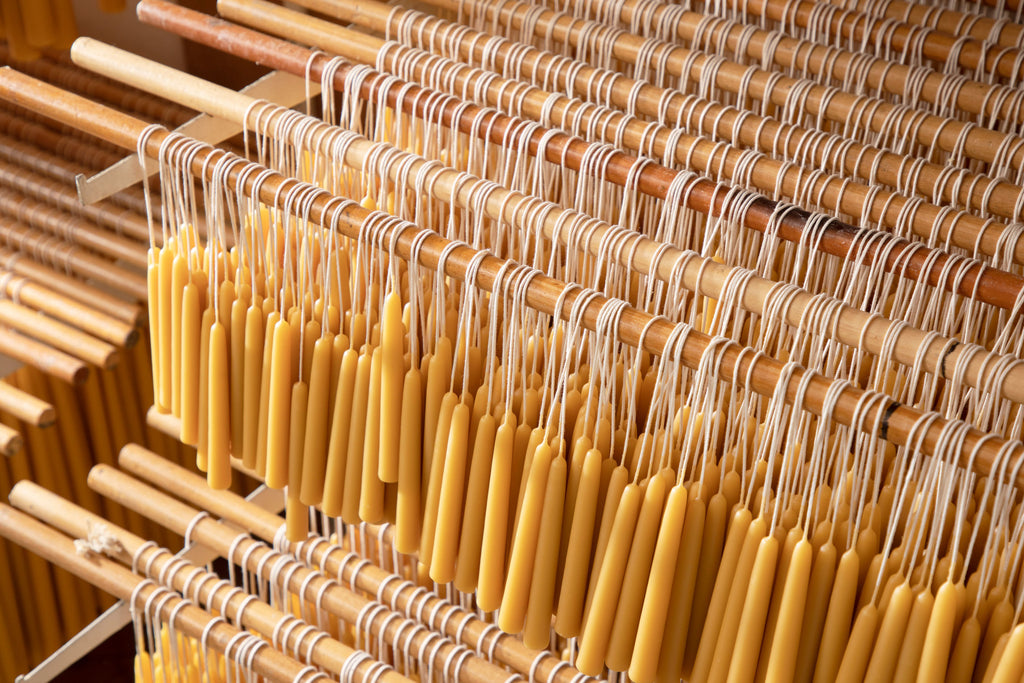Our beeswax candles are 100% natural. They are made locally in the Netherlands by a traditional candle maker. Beeswax candles give a calm flame and spread a delicious aromatic scent. These natural candles have at least twelve burning hours.
what is beeswax?
Honey bees make their nest in a hollow tree, hive or cupboard containing beeswax combs. It is a greasy substance that honey bees make to build their combs with. The combs are made up of hexagonal boxes in which honey and pollen are stored. The hexagonal honeycomb construction is particularly strong and has never surpassed anything in the construction world. The beeswax is made by the bees themselves. A bee population needs a few kilograms of beeswax per year.
The honeybee lives in a population that can consist of more than 50,000 bees in the spring. In the winter the population is much smaller and consists of 5,000 to 10,000 bees. The beekeeper occasionally renews part of the beeswax to ensure that no diseases occur in the bee population. When enough combs have been collected, they are melted in a large melting pan and then poured into trays. Pure beeswax is an important part of the harvest for beekeepers, in addition to the honey itself. Beeswax is soft and malleable from 40° C. That makes it ideal for candles, soaps and nourishing creams mixed with medicinal herbs.
 did you know?
did you know?
For 1 kilo of honey a bee has to fly around the earth six to seven times? And for 1 gram of beeswax, a bee flies from Amsterdam to Istanbul. For a 70 gram candle, a bee must therefore fly around the world more than 3 times.
sweet gold
Beeswax has been linked to human history for thousands of years for a wide variety of applications; it has been found in the tombs of Egypt, in wrecked Viking ships, and in Roman ruins. Beekeeping was a sign of wealth for the Greeks and Romans and they held special honey markets. About 300 years before Chr. Aristotle describes in his 'Historia Animalum' the life of bees. He already knew about the existence of the queen, the drones (male bees) and the workers.  the first beeswax candles
the first beeswax candles
The use of beeswax for candles goes back a long time. It was discovered in ancient times that beeswax with some flax worked well as a light source. In the tomb of the Egyptian pharaoh Tutankhamun (c. 1300 BC) remains of beeswax candles have been found. The Romans also used beeswax candles for lighting but also as a time measurement: 6 candles were burned out in 24 hours. The real breakthrough of the candle in Europe came in the Middle Ages. Making candles became a real craft. The first guilds of candle makers came to England in the 14th century. Many monasteries had a large apiary, especially for harvesting beeswax. In areas with a lot of flowers, beekeepers traveled with their bee colonies through the area and were sometimes away from home for weeks. They stayed with their bee colonies to look after them, but also to guard them against theft. Beeswax candles were only seen in rich families and in churches in the Middle Ages because they were very expensive.
benefits of beeswax candles
- beeswax is long burning
- beeswax is non-toxic
- beeswax is safe for allergies
- beeswax is sustainable, renewable raw material
- beeswax is honest, natural scent
- beeswax is naturally dripless
- beeswax is clean burning
Unlike paraffin candles, our beeswax candles are hypo-allergenic, great for people with allergies or other sensitivities. The perfect choice if you want a clean burning candle in your home.
Shop your beeswax candles
